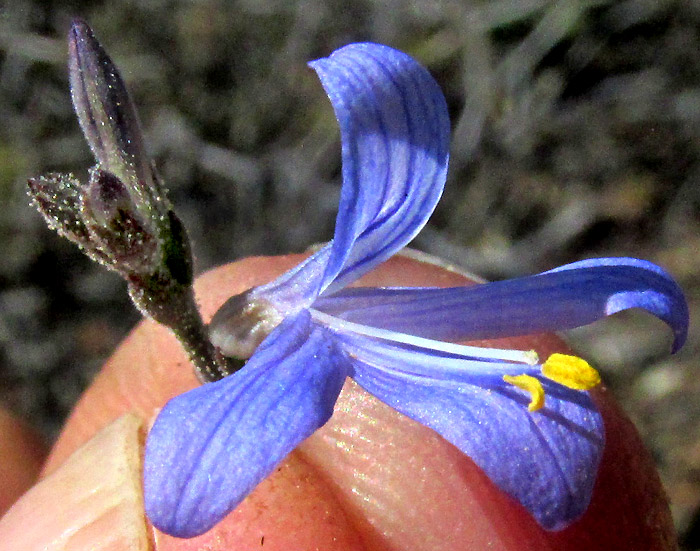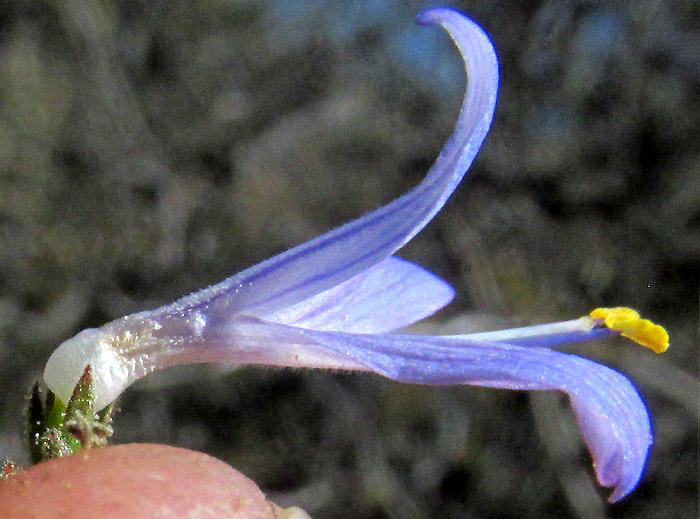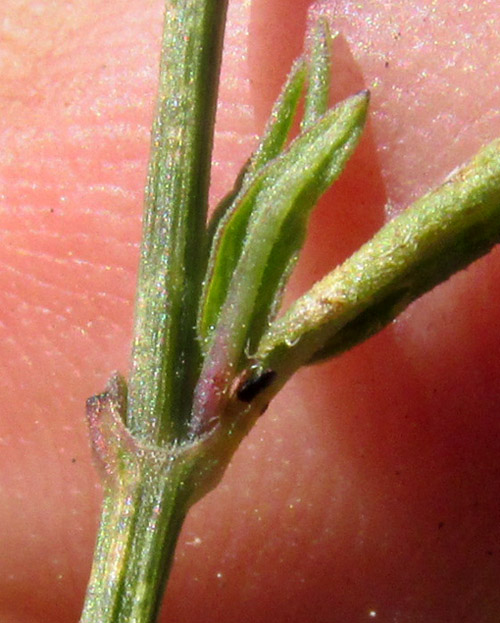Excerpts from Jim Conrad's
Naturalist Newsletter
Entry dated March 7, 2024, from notes taken about 2kms south of Higuerillas, Municipality of Cadereyta de Montes; N20.8872°, W99.7718°, elevation ~1660 meters (~5450 feet); bedrock of volcanic rhyolite; local narrow belt of vegetation constituting an extreme southern extension of the Chihuahuan Desert, Meridional Subregion; central Querétaro state, MÉXICO
SMALLFLOWER WRIGHTWORT

On a rocky hill slope where roving feral burros and cattle kept the undergrowth below scattered mesquite trees clipped low, in a hard-to-reach spot on a steep outcrop of rhyolite rock, the above easy-to-overlook little wildflower managed to blossom.

Up close, the small flower, whose corolla was only about 12mm long (~½ inch), was unexpectedly pretty and displayed unusual features. The corolla was 4-lobed and slightly bilaterally symmetrical. It produced only two stamens, which bore large, yellow anthers showing brightly against the blue corolla. The stamens curved downward, keeping close to the lower corolla lobe, and immediately above the stamens, a long, slender, stigma-tipped style similarly bent downward. It was easy to visualize pollinators landing on the lower lobe and being daubed with pollen while also delivering pollen from elsewhere onto the stigma. An important identification feature is that each flower bud developing on the picture's left side is subtended by a scale-like bract. The open flower also arises above a bract, but it's mostly obscured in the picture. When you see bilaterally symmetrical blossoms with only two stamens, and each flower is subtended by a bract, think "Acanthus Family, Acanthaceae."

When the flower was carefully manipulated for a side view, the entire corolla came loose from its green calyx; in the above photo, it's barely held in position by sepals. Such easy-to-dislodge corolla reminded me of the Viscid Wrightwort, whose white flowers did the same thing, which also occurs in this area, and which is a member of the Acanthus Family. Viscid Wrightworts belong to the genus Carlowrightia, so already I knew where to look for this blue-flowered species.

Above, side stems bearing new leaves are sprouting from the main stem. The leaves are sparse, small, simple and narrow on this species, and arise opposite one another in pairs. Note that the leaves' margins strongly curl under; they're "revolute." At the image's bottom, the stem is seen to devleop squared corners.

The squared stem is better seen above. One leaf of the pair has been nibbled off, but the image shows that at leaf bases there are no stipules. The lack of stipules disqualifies the plant from being a member of the Coffee Family, the Rubiaceae, which can share most features described above.
In our Bajío region of upland central Mexico, three Carlowrightia species have been documented. Of those three, only one species produces blue flowers with leaves whose margins curl under, and that's CARLOWRIGHTIA PARVIFLORA, known in southern Texas as the Smallflower Wrightwort.
Smallflower Wrightworts are distributed from Texas's hot, dry southern part south through Mexico's dry scrub and mesquite uplands to about here in Querétaro state, central Mexico. It's described as relatively common, which isn't surprising for a species able to endure such overgrazing on rocky slopes as seen here.
I find no literature documenting medicinal or other human uses of this small, easily overlooked species, though of course Life on Earth in general makes good use of its photosynthesized oxygen and recycled biomass and nutrients.
The genus Carlowrightia, whose 27 currently accepted species occur only in the southwestern US south into northwestern South America, is named after US botanist Charles (Carlos) Wright (1811-1885). Wright, whose name also graces the common name wrightwort, in 1849 collected plants in southern Texas, discovering around 50 species not yet known to science; our species wasn't one of them. Later he collected in other parts of the world. He seemed to have preferred fieldwork to dealing with the formal taxonomy of the plants he collected.